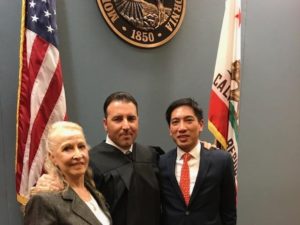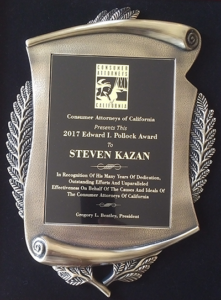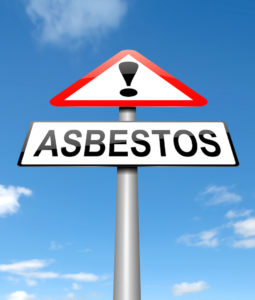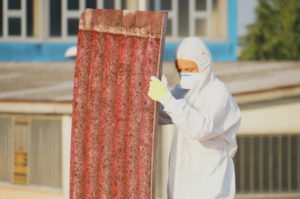Paralleling a similar verdict won in April of 2018, a California jury recently awarded clients of Kazan Law damages totaling $29.5 million. The landmark verdict represents compensatory damages that Kazan clients Teresa Leavitt and her husband, Dean McElroy, suffered as a result of the mesothelioma Mrs. Leavitt contracted from exposure to the asbestos in Johnson’s Baby Powder – arguably the baby powder gold-standard for many decades. The couple is represented by a legal team made up of attorneys from both Kazan, McClain, Satterley & Greenwood, PC, and Levy Konigsberg, LLP.
The Defendants, Responsibility, and Damages
Those defendants ordered to pay the $29.5 million verdict include three entities:
- Johnson & Johnson (J&J)
- Johnson & Johnson Consumer, Inc.
- Cyprus Mines Corporation (Cyprus) – a talc supplier
The jury determined after extensive deliberation, that J&J bore 98 percent of the responsibility for Mrs. Leavitt’s injuries and that Cyprus bore the remaining 2 percent of responsibility. The verdict includes $22 million for Mrs. Leavitt’s past and future pain and suffering caused by the mesothelioma, $5 million for her husband’s spousal damages, which are also known as loss of consortium and loss of services and society, and $2.5 million for economic damages, including medical expenses and lost earnings.
Jury’s Findings
The jury’s findings on several important elements ultimately led to the final verdict in favor of the couple:
- Mrs. Leavitt’s use of Johnson’s Baby Powder was a substantial cause of her mesothelioma.
- J&J and Cyprus failed to provide adequate warning regarding the dangers of asbestos, such as that found in their talc.
- J&J intentionally withheld information regarding the risks associated with the talc found in their famous baby powder.
Supporting Evidence
Evidence in support of this verdict included multiple internal documents issued by both J&J and Cyprus that prove both defendants knew – as early as the 1960s – that the talc used to manufacture Johnson’s baby powder and Johnson and Johnson’s Shower to Shower products contained asbestos. In response to their initial discovery of this dangerous fact, J&J – and some other manufacturers of talcum powder – opted out of replacing the tainted talc with an alternative substance like cornstarch and, instead, implemented a testing mechanism that couldn’t detect the asbestos and, thus, attempted to absolve themselves of potential fault. The jury saw through this attempt.
The evidence presented mirrored evidence from the April 2018 case. It was, however, the first J&J talc-related trial to be completed following reporting from the New York Times and Reuters that established J&J’s long-term awareness of the asbestos issue and its decision to keep the information from both the public and government regulators.
Representation
The plaintiffs, Teresa Leavitt and Dean McElroy, are represented by a legal team that includes Joseph Satterley and Denyse Clancy of Kazan, McClain, Satterley & Greenwood, PC, of Oakland, California, and Moshe Maimon of Levy Konigsberg, LLP, based in New York and New Jersey.
Call Kazan Law Today to Schedule a Free Case Evaluation with a Talcum Powder Lawyer
To schedule a free case evaluation with an attorney, call Kazan Law today at 888-990-7008 or contact us online.
 If you’ve found yourself on this page, chances are that you are looking into mesothelioma law firms, either for yourself or for a loved one who has been diagnosed with mesothelioma. As you’re probably well aware, mesothelioma is a specific type of cancer that only occurs after a person has been exposed to asbestos. Due to federal and state law, people who have been exposed to asbestos and develop mesothelioma are entitled to compensation.
If you’ve found yourself on this page, chances are that you are looking into mesothelioma law firms, either for yourself or for a loved one who has been diagnosed with mesothelioma. As you’re probably well aware, mesothelioma is a specific type of cancer that only occurs after a person has been exposed to asbestos. Due to federal and state law, people who have been exposed to asbestos and develop mesothelioma are entitled to compensation.


 Congratulations to Steven Kazan, Founding, Senior and Managing Partner of Kazan Law on this achievement!
Congratulations to Steven Kazan, Founding, Senior and Managing Partner of Kazan Law on this achievement! Mesothelioma is a rare and deadly form of cancer caused by past exposure to asbestos. Many individuals and their surviving family members have filed suit, but others may lose the opportunity to receive compensation because of the mesothelioma statute of limitations.
Mesothelioma is a rare and deadly form of cancer caused by past exposure to asbestos. Many individuals and their surviving family members have filed suit, but others may lose the opportunity to receive compensation because of the mesothelioma statute of limitations. Mr. Michael Burch was diagnosed with pleural mesothelioma in May of 2016 when he was 64 years old. A lifelong California resident, he and his wife Cindy raised four daughters and have four grandchildren.
Mr. Michael Burch was diagnosed with pleural mesothelioma in May of 2016 when he was 64 years old. A lifelong California resident, he and his wife Cindy raised four daughters and have four grandchildren. In an effort to escape their massive legal liabilities, many large companies that used asbestos in their products or working environments have filed for Chapter 11 bankruptcy protection. In order to make sure that victims of asbestos-related diseases are compensated fairly, the U.S. Congress has determined that these companies must establish an asbestos trust fund when they file for bankruptcy protection. This ensures that future victims will be able to get the financial compensation they deserve.
In an effort to escape their massive legal liabilities, many large companies that used asbestos in their products or working environments have filed for Chapter 11 bankruptcy protection. In order to make sure that victims of asbestos-related diseases are compensated fairly, the U.S. Congress has determined that these companies must establish an asbestos trust fund when they file for bankruptcy protection. This ensures that future victims will be able to get the financial compensation they deserve. Asbestos was used frequently from the beginning of the 20th century in a variety of building materials. In the 1970s, the public learned what the asbestos industry had known for 60 years – that asbestos is highly toxic and that inhaling its fibers can cause lung scarring, lung cancer, and mesothelioma.
Asbestos was used frequently from the beginning of the 20th century in a variety of building materials. In the 1970s, the public learned what the asbestos industry had known for 60 years – that asbestos is highly toxic and that inhaling its fibers can cause lung scarring, lung cancer, and mesothelioma.